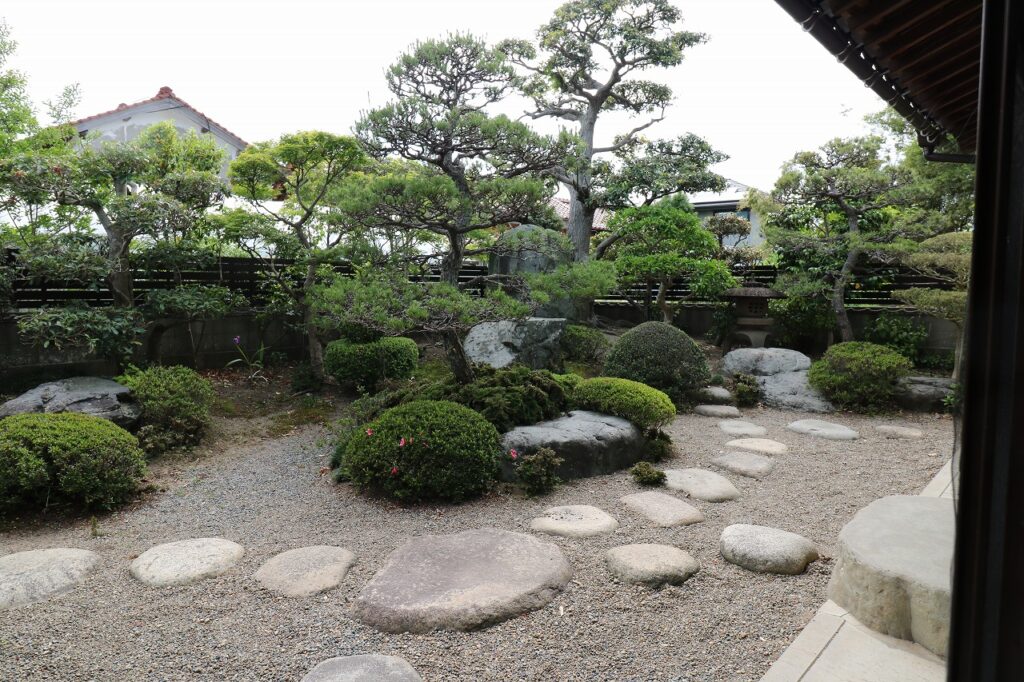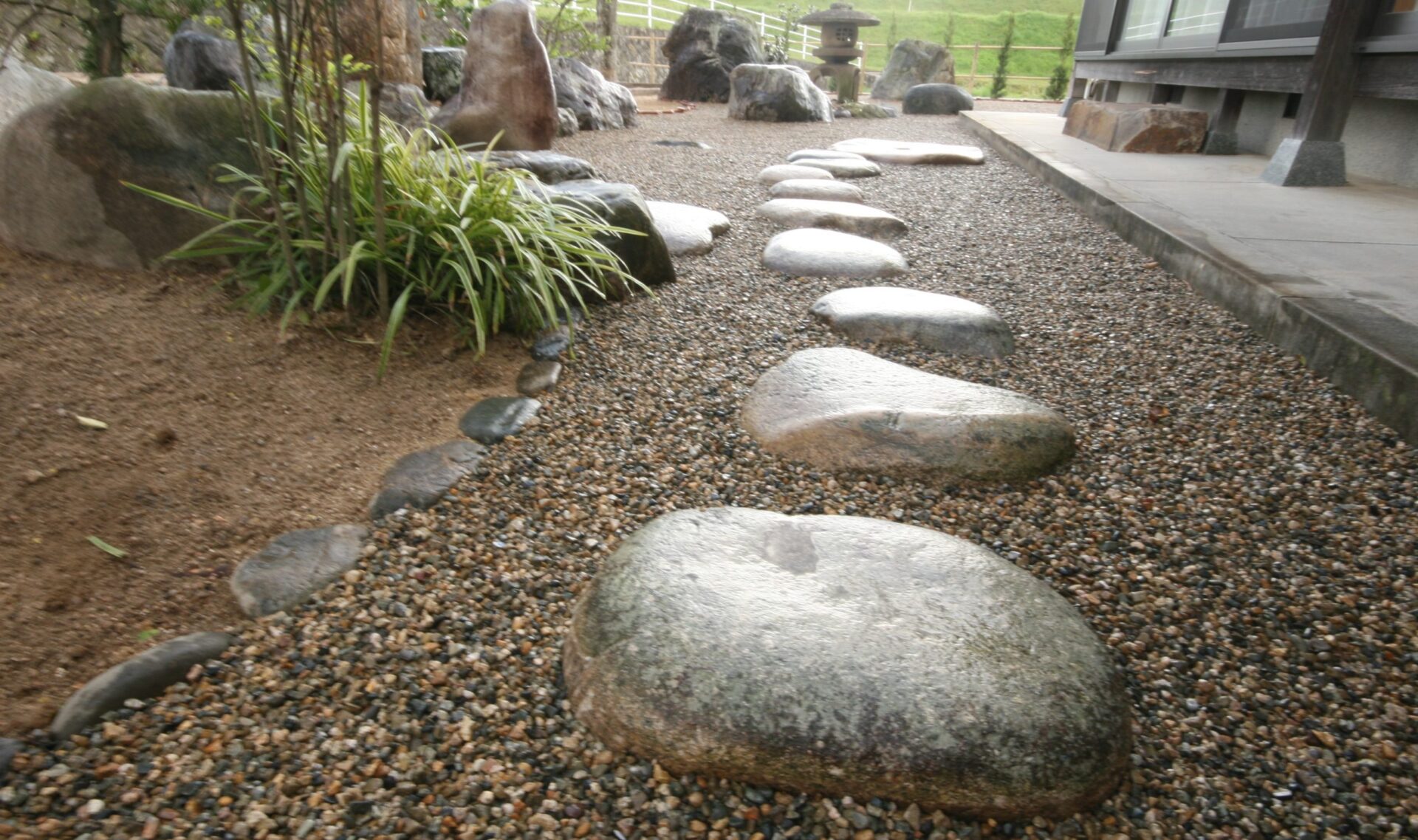In the Izumo region of Shimane Prefecture, a uniquely developed Japanese garden is called the Izumo-style garden. What are the characteristics of Izumo-style gardens? In this article, we will look at the characteristics of stepping stones.
The Izumo-style garden has changed over the course of time in the Edo period, Meiji period, and Showa period. In this article, we will look at the characteristics of stepping stones throughout the three eras.
What are the stepping stones for?
To begin with, what are stepping stones for? Naturally, you can imagine that they are there for walking on stepping stones. It is true that if you walk on stepping stones, you will not leave footprints on the gravel, and you will not damage moss or plants. Stepping stones are also placed in such a way that they are wide and positioned in such a way that they are easy to walk on.
So where do you go by walking on stepping stones? For example, stepping stones may be there for strolling in the garden. Many Japanese gardens have a pond around which you can stroll. In such cases, stepping stones are placed for strolling.
How about Izumo-style gardens? In some Izumo-style gardens, which were built in the Meiji era (1868-1912) in the mansions of wealthy farmers, you can walk around in a circle by crossing stepping stones. For example, the Izumo-style garden at the Izumo Cultural Heritage Museum.
However, if you observe the stepping stones carefully, you will find that they always have a detour. In other words, when you cross a stepping stone, you will end up at a place where you have something to do.
In the Izumo-style gardens of private residences built in the Showa period (1926-1989), as many as 2,000 or 3,000 steppingstones were built. The places of business are the veranda of the tatami room, the lanterns, the tsukubai, and the central gate. The veranda of the tatami room is designed to allow access to the tatami room. The lanterns can be lit by fire. The tsukubai is for washing hands. The middle gate leads from the outside to the tatami room.
Of course, you do not have to actually light the lanterns or wash your hands in the tsukubai to see that the stepping stones connect them so that you can do your business.
In other words, the stepping stones are not just for walking, but also for doing the errands of the garden’s facilities.
And they are arranged in such a way that you can picture the scene by looking at the steppingstones rather than actually using them, thus giving a story to the garden.

Stepping stones set high
One of the features of stepping stones in Izumo-style gardens is that they are taller than usual. The usual stepping stones are those found in Kyoto and other places in Japan.
Some of you may have heard that Japanese gardens, especially tea gardens called “Roji” (open-air tea ceremony garden), are created in a simple and unobtrusive manner in the spirit of wabi and sabi (beauty and simplicity). Therefore, stepping stones are lowered to just above the ground to create a wabi-sabi atmosphere.
On the other hand, if steppingstones are placed high, they look gaudy. The stepping stones look magnificent.
Why, then, are stepping stones set so high in Izumo-style gardens? It is said that it is because of the hospitality of the so-called “Honjin,” the inn where the lord of Matsue Castle used to stay when he visited Izumo-Grand Shrine in the Edo period (1603-1868). It is said that the stepping stones were placed so that even if there was some snow in winter, the stepping stones could be walked on and tea ceremonies could be held.

Stone mortar mixed with stepping stones
You will notice that there is something other than stepping stones in the stepping stones, not always, but quite often.
It is a millstone. It is easy to find when you look. The location is used near the center.
This is not a feature unique to Izumo-style gardens, as it can be found in other regions as well, but it is one of the features of Izumo-style gardens because it is very common.
The reason for this is that the Izumo region thrived on rice paddies, and a stone mortar was probably a familiar tool used every day. A wealthy farmer’s mansion would have used many millstones. A beautiful round stone millstone, artificially created among natural river stones, would be eye-catching in terms of design. The stepping stones would also be varied and beautiful in design.
A millstone is also a tool of commerce. Since Japanese gardens are meant to bring good luck, it may have been to wish for the further prosperity of business.
The exact reason for this is still under study. However, it is a very interesting feature!

Identity of unusually large stones among stepping stones
Stepping stones are easy to walk on because they are usually lined with stones of about the same size. However, in the Izumo-style garden, the stepping stones are not just a little bit big, but very big.
Not just a little big stones, but very big stones. If the size of a normal stone is between 20 cm and 30 cm in diameter, a large stone is as large as 1 meter or 2 meters.
These stepping stones are called palanquin stones or palanquin stands. A palanquin is a palanquin carrying a lord. When the lord arrives at the Honjin as mentioned above, he enters in a palanquin from the Onarimon gate, places the palanquin on the palanquin stone, and enters the Shoin immediately after getting off the palanquin.
Even today, when the lord is not present, a very large stepping stone called “palanquin stone” still exists as a remnant.

Stepping stone taboos have no place in Izumo
Stepping stones are subject to several commitments in the gardener’s world. One of them is that stepping stones should not be placed in a crisscross pattern.
However, in Izumo-style gardens, they are arranged in a crisscross pattern. However, it is not just a crisscross pattern, but the stones are arranged in a way that they harmonize well with each other by varying the size of the stones.
Why did this happen? The technique of Japanese gardens, which once developed mainly in Kyoto, spread throughout the country. However, the Izumo region was not so influenced by it, and this is thought to be proof that the unique garden techniques of the Izumo region flourished.

The stepping stones in the Izumo-style garden are very conspicuous because they are set in a large area of gravel in the garden. The unique way of placing steppingstones in the garden is also well known, and one can easily recognize it as an Izumo-style garden. It is probably rare to find a garden with such a high presence of stepping stones in the whole country. Therefore, by understanding the meaning of stepping stones, one can understand the profound value of Japanese gardens. The Izumo-style garden is a garden that should be called an asset to inherit the history and culture that developed in the Izumo region.


